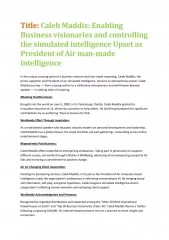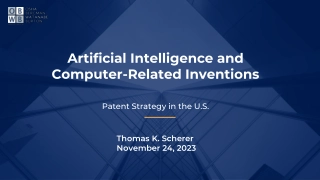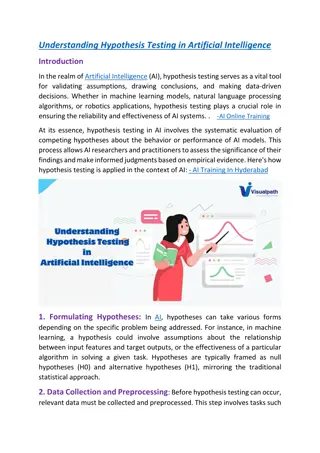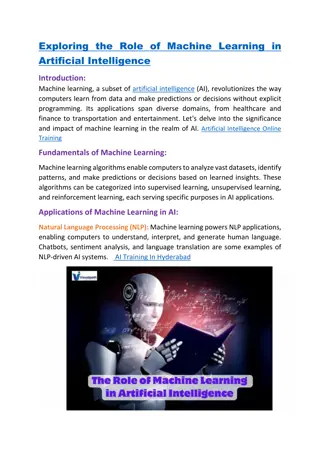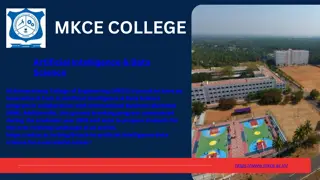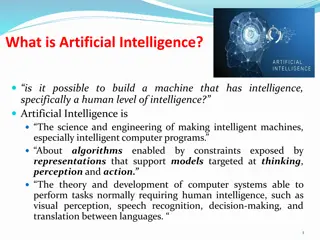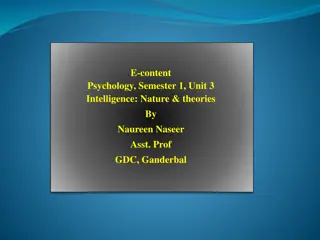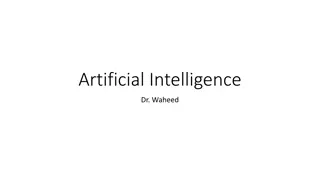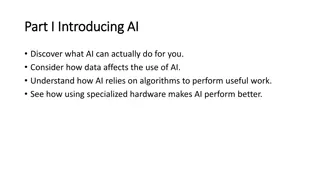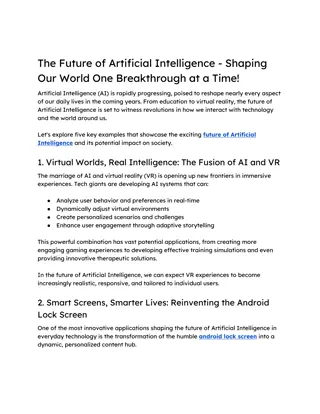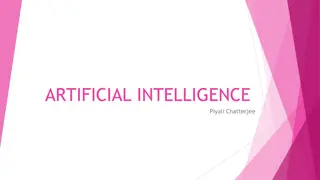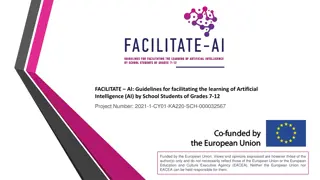Facilitating Artificial Intelligence Learning for School Students
In this project funded by the European Commission, guidelines are provided for facilitating the learning of Artificial Intelligence (AI) by school students in grades 7-12. The focus is on introducing students to AI innovation, creativity, and entrepreneurship, with learning outcomes covering AI in innovation management, market research, business education, digitalization, and startup development.
Download Presentation

Please find below an Image/Link to download the presentation.
The content on the website is provided AS IS for your information and personal use only. It may not be sold, licensed, or shared on other websites without obtaining consent from the author. Download presentation by click this link. If you encounter any issues during the download, it is possible that the publisher has removed the file from their server.
E N D
Presentation Transcript
FACILITATE AI: Guidelines for facilitating the learning of Artificial Intelligence (AI) by School Students of Grades 7-12 Project Number: 2021-1-CY01-KA220-SCH-000032567 This project has been funded with support from the European Commission. This PowerPoint reflects the views only of the author, and the Commission cannot be held responsible for any use which may be made of the information contained herein. information contained herein. This project has been funded with support from the European Commission. This PowerPoint reflects the views only of the author, and the Commission cannot be held responsible for any use which may be made of the Education and Culture Executive Agency (EACEA). Neither the European Union nor EACEA can be held responsible for them. Funded by the European Union. Views and opinions expressed are however those of the author(s) only and do not necessarily reflect those of the European Union or the European
C1 Training course: Innovation - Creativity Entrepreneurship Result 1, A1/T1 Module Number and Area/ Topic: Innovation - Creativity - Entrepreneurship Module owners: USH , IT-School Coordinator Costin Lianu Project Number: 2021-1-CY01-KA220-SCH-000032567
Introduction and Broad Description of the Context and Goal of the area/ topic addressed: This module will provide introductory knowledge on basic aspects on how AI can be used for the innovation management system underpinning the design, and the development of innovative products as well as the understanding of its importance in the context of the other activities of business management. Learning outcomes and learning objectives : Part 1- Introduction to AI Innovation Part 2- Conducting market researches in AI field Part 3- Developing Business oriented education Part 4- Digitalization through Innovation ecosystems and technology transfer within Clusters and strategic alliances Part 5 - Creation and Development of Start ups Case study presentation Project Number: 2021-1-CY01-KA220-SCH-000032567
Learning Objectives Understanding the need for innovation, its role at the company and society level and the strategic framework for innovation Understanding what is creativity, invention and innovation in order to make the difference Understanding the power of cooperation Acquisition of basic knowledge on innovation management at the level company; Knowledge of techniques and methods to stimulate creativity and innovation; Acquiring some basic notions regarding property management intellectuals; Understanding the basics of innovative projects and transfer technological; Mastering the operation of innovation management by identifying leaders, innovative teams and innovative networks; Knowledge of innovation management tools and techniques Project Number: 2021-1-CY01-KA220-SCH-000032567
Learning Outcomes Master its own creativity in an AI environment Learn how to protect ideas and how to cooperate Learning the steps to move from creativity to experiments and applied research Research, development, innovation Developing skills for conducting experiments Entrepreneurial development, business acceleration Business oriented education Innovation ecosystems and technology transfer Clusters and strategic alliances and applied Creation and Development of Start ups Digital transofmation base on AI Project Number: 2021-1-CY01-KA220-SCH-000032567
Partners Partnerships with the associative structures of the business environment - through which was created the appropriate cooperation between academia and entrepreneurship, involving associative structures of business. This partnership led to the creation of a Knowledge Transfer Center; The program Meet the Markets/ Joint Business Support concept organizes events, conferences, workshops, B2B contacts, debates on thematic areas of maximum interest in order to develop entrepreneurial skills and performance. Partnership protocols with associations, clusters and companies in order to create and develop an appropriate framework for long-term cooperation patterns with companies and associations, so that they benefit from increased assistance from our center. USH Pro Business actively contributed to the creation of clusters and it is member of the following cluster type structures: Bio Danubius, Bio Concept Valea Prahovei, Danube Furniture Cluster, Danube Engineering Hub, CERMAND (Cluster for Renewable Energy in the Black Sea and Danube), Smart Alliance, Wallachia eHub, Dual Use Cluster. The University has organized an interprofessional association INTER-BIO for organic farming producers. Project Number: 2021-1-CY01-KA220-SCH-000032567
Instruments/ Tools/ Supporting Material/ Resources Intel Skills for Innovation (SFI) OECD Conceptual Learning Framework UNESCO Digital Library Technological Innovation in Education (2022- 2025) Childhood Education on AI Project Number: 2021-1-CY01-KA220-SCH-000032567
Objectives and outcomes Learning Objectives Understanding the need for innovation, its role at the company and society level and the strategic framework for innovation Understanding what is creativity, invention and innovation in order to make the difference Understanding the power of cooperation Acquisition of basic knowledge on innovation management at the level company; Knowledge of techniques and methods to stimulate creativity and innovation; Acquiring some basic notions regarding property management intellectuals; Understanding the basics of innovative projects and transfer technological; Mastering the operation of innovation management by identifying leaders, innovative teams and innovative networks; Knowledge of innovation management tools and techniques Learning Outcomes Master its own creativity in an AI environment Learn how to protect ideas and how to cooperate Learning the steps to move form creativity to experiments and applied research Research, development, innovation Developing skills for conducting experiments Entrepreneurial development, business acceleration Business oriented education Innovation ecosystems and technology transfer Clusters and strategic alliancesand applied Internationalization Creation and Development of Start ups Digitization Project Number: 2021-1-CY01-KA220-SCH-000032567
Part I Introduction 1. If you want to get more complexity, please take first the basics a college professor in economics some time ago 2. AI and the machine learning cannot replace you (us) but can help you to innovate Project Number: 2021-1-CY01-KA220-SCH-000032567
Mohit Joshi : AI is useless in two significant ways: it has no creativity and no capacity for compassion or love. Rather, it s a tool to amplify human creativity. His solution? Those with jobs that involve repetitive or routine tasks must learn new skills so as not to be left by the wayside. Amazon even offers its employees money to train for jobs at other companies. Klara Nahrstedt, a computer science professor at the University of Illinois at Urbana Champaign and director of the school s Coordinated Science Laboratory ;One of the absolute prerequisites for AI to be successful in many [areas] is that we invest tremendously in education to retrain people for new jobs, . Project Number: 2021-1-CY01-KA220-SCH-000032567
AI in our future life As innovators and entrepreneurs, in business As consumers In geo-politics In our health In reserch In climate change mitigation and Eath Health Project Number: 2021-1-CY01-KA220-SCH-000032567
PART I Introduction , definitions (I) 1. Most definitions of innovation are pointing out to novelty or bringing something new (from the Greek word from which it derived) or an improvement of something mostly recognizable by the consumers in the market. Innovation often takes place through the development of value added products, processes, services, technologies, art works or business models that innovators make available to markets, governments and society. Innovation is related to, but not the same as, invention. innovation is more apt to involve the practical implementation of an invention (i.e. new / improved ability) to make a meaningful impact in a market or society, and not all innovations require a new invention. 2. An innovator as person or organization has to have entrepreneurial skills Project Number: 2021-1-CY01-KA220-SCH-000032567
Introduction , definitions (II) process is a process within an overall engineering and product development process. It may be an improvement upon a machine or product or a new process for creating an object or a result. An invention that achieves a completely unique function or result may be a radical breakthrough. Such works are novel and not obvious to others skilled in the same field. An inventor may be taking a big step toward success or failure. An inventor is an entity that creates or discovers an invention. An inventor may not be a innovator .His main skills are not entrepreneurial word inventor comes from the Latin verb invenire, invent-, to find. Although inventing is closely associated with science and engineering, inventors are not necessarily engineers or scientists but also other types of creative minds like artists. Due to advances in artificial intelligence, the term "inventor" no longer exclusively applies to an occupation but also to group predictions combining human computing and coding with digital computing. An invention is a unique or novel mechanism, method, composition or process. The invention but technical or scientifical. The Project Number: 2021-1-CY01-KA220-SCH-000032567
Introduction , definitions (III) Creativity on the other hand involves the production of novel, useful products based more on individual talent, beein the mostly focussed on individual skill or something original and usufull whcih a single mind can develop described as a mind process of making original associtions of ideas, metaphorizing, missing knowledge elements identification, searching for solutions, making guesses, or formulating hypotheses and other knowledge processes.Creativity in general is usually distinguished from innovation in particular, where the stress is on implementation. For example, the OECD and Eurostat state that "Innovation is more than a new idea or an invention. An innovation requires implementation, either by being put into active use or by being made available for use by other parties, firms, individuals or organisations New knowledge on creartivity defines computation creativity : J rgen Schmidhuber theory of creativity postulates that creativity, curiosity, and interestingness are by-products of a simple computational principle for measuring and optimizing learning progress. Imagine AI solution able to manage environment for a certain purpose : personal, social, ecosystem and try to make more indepth research case Project Number: 2021-1-CY01-KA220-SCH-000032567
Understand the differences Tracing through examples the way AI: 1.As a creative mind (new ideas in creating an app, game etc, screening ideas etc) 2. As a inventor (make a prototype of game, of a solution etc) 3. As innovator (use AI to test possible consumer for a game,algorithm,solutions, etc) Creativitity Inventions Innovation (What if? The machines cannot answer these question. You are on the Project Number: 2021-1-CY01-KA220-SCH-000032567 driving seat )
Still ours, computer cannot do: 1.Empathy 2.Creativity 3.Judgment 4.Planning 5.Physical skill Project Number: 2021-1-CY01-KA220-SCH-000032567
Follow the pathway of a new game using AI : 1. Envision what do not exist through googling, data collection 2. Imagine a new game and make a prototype on the computer 3. validate you are unique base on test and data interpretation 4. Test th epossible clients redi ness to buy Project Number: 2021-1-CY01-KA220-SCH-000032567
Part 2- Basic roadmap Conducting applied researches in AI field, from creative minds to invention and business application ( innovation) Project Number: 2021-1-CY01-KA220-SCH-000032567
Main pathways to AI driven innovation the use of artificial intelligence technologies in the process of innovation." Positioned on the rise of an innovation trigger, we believe, AI-driven innovation is considered to hold potentially transformative means to drive high-impact innovation at scale through the discovery of new ideas and rapid progress through the innovation pipeline . Gartner says, this suggests that the innovation management technique will enable new ways of doing business across industries, resulting in significant shifts in industry dynamics. General management of innovation based on AI innovations is already mainstream Specific AI innovation solutions approach , as a innovation in the technical and computation field itself Computation power :For all of the technological progress in computing hardware, and the much debated lifespan of Moore s Law, computer performance is only one side of the picture. Improved algorithms: Behind the scenes a second trend is happening: Algorithms are being improved, so in turn less computing power is needed. While algorithmic efficiency may have less of a spotlight, you d definitely notice if your trusty search engine suddenly became one-tenth as fast. What I may be ? A new algorithm and computation techniques developer or enlighten business or organizational transformer using AI ? Project Number: 2021-1-CY01-KA220-SCH-000032567
Option :Technological readiness pathways Project Number: 2021-1-CY01-KA220-SCH-000032567
Non-technological option (Innovation Process Optimization Augmented Business Operations) Non-technological innovation focuses on all the innovation activities of an organization that are excluded from using technological new, including organizational and marketing innovation new or significantly amended forms of organization, business structures or practices, aimed at reducing costs, improving internal efficiency or effectiveness and approaching markets and customers Marketing innovation emphasizes the implementation of new marketing methods concerning significant changes in the promotion, packaging, or placement of display products and product design and appearance, which is not related to functional characteristics; Imagine a non technological innovation in AI solutions (how to apply an algorithm already developed in another field as an example) Project Number: 2021-1-CY01-KA220-SCH-000032567
New technologies and market access Project Number: 2021-1-CY01-KA220-SCH-000032567
Creativity techniques Various creativity techniques that have been proposed. These include approaches that have been developed by both academia and industry: Establishing purpose and intention Building basic skills Encouraging acquisitions of domain-specific knowledge Stimulating and rewarding curiosity and exploration Building motivation, especially internal motivation Encouraging confidence and a willingness to take risks Focusing on mastery and self-competition Promoting supportable beliefs about creativity Providing opportunities for choice and discovery Developing self-management (metacognitive skills) Teaching techniques and strategies for facilitating creative performance Providing balance Project Number: 2021-1-CY01-KA220-SCH-000032567
The eduactional side for creativity this as important because technology is advancing our society at an unprecedented rate and creative problem solving will be needed to cope with these challenges as they arise In addition to helping with problem solving, creativity also helps students identify problems where others have failed to do so. Promoting motivation and problem solving are two areas where educators can foster creativity in students. Students are more creative when they see a task as intrinsically motivating, valued for its own sake. To promote creative thinking, educators need to identify what motivates their students and structure teaching around it. Providing students with a choice of activities to complete allows them to become more intrinsically motivated and therefore creative in completing the tasks Teaching students to solve problems that do not have well defined answers is another way to foster their creativity. This is accomplished by allowing students to explore problems and redefine them, possibly drawing on knowledge that at first may seem unrelated to the problem in order to solve it. In adults, mentoring individuals is another way to foster their creativity.[262]However, the benefits of mentoring creativity apply only to creative contributions considered great in a given field, like AI provide a creativity-friendly, rich, imagination-fostering environment for young children. Researchers have seen Project Number: 2021-1-CY01-KA220-SCH-000032567
Pathways It involves looking at familiar things with a fresh eye, examining problems with an open mind, making connections, learning from mistakes and using imagination to explore new possibilities. The need to develop a shared language and understanding of creativity and its role across every aspect of learning, teaching and continuous improvement was identified as a necessary aim[and a set of four skills is used to allow educators to discuss and develop creativity skills across all subjects and sectors of education curiosity, open-mindedness, imagination and problem solving. Distinctions are made between creative learning (when learners are using their creativity skills), creative teaching (when educators are using their creativity skills) and creative change (when creativity skills are applied to planning and improvement). Project Number: 2021-1-CY01-KA220-SCH-000032567
Mindset example of possible use cases in AI in gamification creativity invention facilitating AI tools for developing creative mindset to the student innovation using AI to transform idea into an invention and an IPR using AI to implement inventions, to acces the markets Ex: create a new game based on your skills using computational technics Ex: based on AI develop content and IPR control on the game Ex. based on AI develop a new product (app) of the game on a digital platform and make revenues Project Number: 2021-1-CY01-KA220-SCH-000032567
Where you can innovate in non technological areas using AI Project Number: 2021-1-CY01-KA220-SCH-000032567
PART 3, ecosystems study cases - university entrepreneurial centers practices - Clusters involvement - Linkages with colleges networks - Using digital hubs - Connecting labs - Living labs initiatives Project Number: 2021-1-CY01-KA220-SCH-000032567
Entrepreneurial angle University experience) - Training the students minds in an entrepreneurial way about the market value of AI technology adoption; - Successful business cases presentation of AI market deployments; - Successful use of AI in decision making (starting from daily examples how marketers are suing AI for predicting consumer behaviour) - Open the school to manager - Competence knowledge - Enhance entrepreneurial motivation entrepreneurial centers practices (USH ProBusiness Project Number: 2021-1-CY01-KA220-SCH-000032567
Networking and group angle Clusters involvement - Importance of clustering and networking in using AI - Collaborative model of learning to use networks , or be able to initiate CoPs, structured dialogue based on roles ( to develop a simulated solution : ideation, research, validation, road to market) - Transforming tacit knowledge into a group knowledge as a learning pathway Project Number: 2021-1-CY01-KA220-SCH-000032567
Knowledge about digital transformation - Recognize the topics and the role of AI - Using digital hubs to attract students job orientation - Connecting student with Living labs initiatives Project Number: 2021-1-CY01-KA220-SCH-000032567
IPR protection angle Protection of: idea of the algorithm, algorithm its self, data design and collection but whilst an algorithm itself, in absent context, is too abstract to be patented, a practical application of the algorithm may well be patentable. And this can be the case even where the only difference between what is already known and your new innovation is the algorithm itself. It may differ form one country to another; Collective protection vs individual protection; Protection through innovation on the market is the surest pathway Your digital/entrepreneurial ecosystem may help to get more specific knowledge The machine results as work of art are not protected The machine cannot be considered an inventor Imagine AI in music through this angle Project Number: 2021-1-CY01-KA220-SCH-000032567
Examples Algorithms can be patented when they are used for a specific technical purpose: digital image or video enhancement or analysis, e.g. detecting persons in a digital image speech recognition, e.g. mapping a speech input to a text output determining the energy expenditure of a subject by processing data obtained from physiological sensors deriving the body temperature of a subject from data obtained from an ear temperature detector providing a genotype estimate based on an analysis of DNA samples, as well as providing a confidence interval for this estimate so as to quantify its reliability providing a medical diagnosis by an automated system processing physiological measurements Project Number: 2021-1-CY01-KA220-SCH-000032567
Individual versus group teaching digital skills (AI included) All students can learn and succeed, but not in the same way and not in the same day William G. Spady Pros for group the group learning condition yielded better grades than did the individual learning condition, with a mean difference of approximately fifteen percentage points. (https://rdw.rowan.edu/cgi/viewcontent.cgi?ar ticle=2156&context=etd) It creates competition (Michelson) Pros for individual Individual work in an online setting should not be considered loneliness. The student should interact both with the instructor and with those preparing the lesson Faster identification of creative abilities Individual learning may be more in depth based on specific abilities and successful junior achievements Project Number: 2021-1-CY01-KA220-SCH-000032567
FACILITATE AI Partners Project Number: 2021-1-CY01-KA220-SCH-000032567


